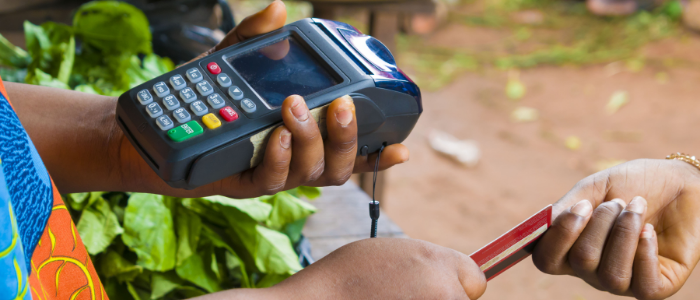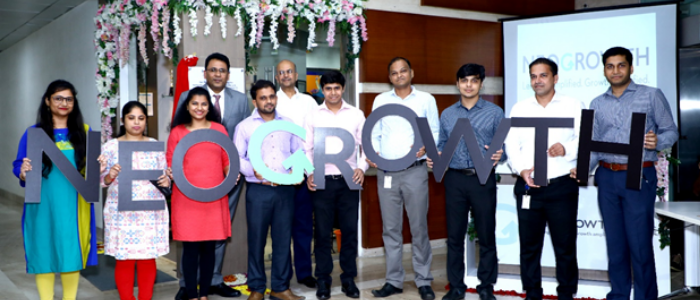By Leela Vosko
When you think about a microfinance lender today, what comes to mind? Since the Grameen Foundation first popularized the concept of microfinance in the 1970s, the landscape has changed. The industry has expanded its suite of offerings to include savings, insurance products, as well as Small Medium Enterprise (SME) loans. At the same time, these Microfinance Institutions (MFIs) have sought to incorporate new tech solutions to improve operations and the overall customer experience.
Historically, MFIs resembled traditional banks in developed markets with a physical location, in-person customer service and a reliance on paper intensive processes. Just as banks have been forced to digitize in response to demands from customers and the imperative to realize operational savings to offer more competitive interest rates to their borrowers, the microfinance industry finds itself on the same journey of evolution towards digitally-enabled financial services.

Some digital financial institutions, mostly fintech lenders like Tala and Branch International, are direct challengers to incumbent MFIs. By sourcing their capital from off-balance sheet facilities and adopting a direct-to-consumer customer acquisition strategy, they use proprietary mobile applications to offer consumer loans.
However, Microfinance and SME Finance Institutions are quickly leveraging technology to better serve their customers to meet the challenge posed by fintech lending upstarts with several significant advantages. MFIs have lending licenses, know how to operate as regulated entities, and typically offer significantly lower interest rates compared to consumer-lending apps (Among the institutions in our portfolio, we typically see average interest rates of 25% across Microfinance and SME loans. This is in contrast to the 180%+ rates charged by apps like Tala)1. Furthermore, the best-in-class MFIs that MicroVest invests in adhere to strict client protection principles to avoid default and creating debt spirals for its borrowers.
Increasingly, MicroVest is watching as our portfolio of Microfinance and SME Finance Institutions develop greater sophistication in gathering and analyzing data while building workflow processes that streamline loan origination and collection. In many cases, these institutions’ knowledge of their customers and communities informs how they integrate technology and design new customer journeys. As these businesses aim to grow and reach more borrowers in their communities, they increasingly have greater access to intelligence and insights that can help them plot strategy growth with greater confidence.
Below, MicroVest is proud to highlight several current and pipeline portfolio companies that are at the forefront of becoming digitally-enabled financial institutions.
NeoGrowth: Incorporating Alternative Data to Streamline Underwriting

Underserved small businesses often face difficulty in accessing working capital and face timing mismatches between cash collection and payment of expenses. Payment delays and long credit cycles only exacerbate this problem. In response to this pain point, the India-based, Non-Bank Financial Company (NBFC) NeoGrowth, launched a digitally-enabled loan product called Vendor Finance Express, to provide fast and efficient access to finance for underserved micro and small businesses. Using an automated scorecard for credit decision-making, NeoGrowth can process applications and disburse funds within 48 hours. Because the product is designed for small businesses with at least three years of operating history, NeoGrowth leverages the information conveyed by this historical track record instead of relying on the borrower to produce invoice documentation at the point of application. This greatly reduces the time to access credit while ensuring that NeoGrowth still has the data required to make sound underwriting decisions.
Annapurna: Anticipating the Impact of Natural Disasters on Borrowers through Geospatial Mapping

Annapurna is a leading Indian MFI at the forefront of microfinance technology and innovation. The company’s in-house Geographic Information System (GIS) for example, renders spatial data into maps that are useful in identifying risks posed by losses from natural disasters. In a region beset by natural disasters like floods, cyclones, and tsunamis, Annapurna performed a vulnerability analysis and hazard assessment using models fed with historical data. This allowed the organization to proactively identify vulnerable clients and design need-based products that can help them withstand a financial shock in the aftermath of a disaster.
When MicroVest visited Annapurna in 2019, we were given a demonstration of the rapid and efficient response to a major cyclone that swept through the Odisha region that year. By embedding geographic, census, financial, and meteorological data into the GIS, Annapurna was able to quickly and efficiently pinpoint customers and determine relief and outreach options swiftly while still managing risk prudently.
Credo Bank: Integrations with Global Fintech Apps
In another trend, we are witnessing Microfinance and SME Finance Institutions integrate with existing payment channels that have been built by global technology and payments companies. For example, Credo Bank, a Georgia-based MFI, recently partnered with Apple Pay to launch Apple Pay contactless payments for the bank’s Mastercard holders. Credo Bank customers now have access to many of the conveniences of Apple Pay that users in developed markets take for granted. To complete purchases, they no longer need to display a physical card, re-enter billing information or fill out length payment forms. Instead, they can simply use their Apple devices to make payments everywhere Mastercard is accepted.
Looking Ahead
While each of our Microfinance and SME Finance Institutions are moving at a different pace with respect to fintech adoption, the trend is unmistakable and accelerating. The speed at which fintech solutions have transformed the financial services industry in North America, Europe and East Asia points the way forward for many developing economies in which MicroVest operates. Incumbent Microfinance and SME Finance Institutions have built a responsible, customer-centric culture that is now benefitting from the incorporation of new sources of data and the use of technology to remove friction from their core processes. The end result? A more inclusive, competitive, and sustainable financial sector with responsible tech-enabled Microfinance and SME Finance Institutions leading the way toward financial inclusion for underserved borrowers.
1Bloomberg Businessweek: https://www.bloomberg.com/news/features/2020-02-12/tech-startups-are-flooding-kenya-with-apps-offering-high-interest-loans
DISCLOSURE INFORMATION
The information contained in this document has been provided by MicroVest Capital Management LLC (“MicroVest”) and no representation or warranty, expressed or implied is made by MicroVest as to the accuracy or completeness of the information contained herein. Specific portfolio or pipeline companies discussed are for educational purposes only and do not represent all of the portfolio holdings and it should not be assumed that investments in the portfolio or pipeline company identified and discussed were or will be profitable. The companies profiled were selected based on their unique uses of technology in the context of social impact, with no reference to amount of profits or losses, realized or unrealized. This document is for informational purposes only and is neither an offer to sell nor a solicitation of an offer to purchase an interest in any MicroVest product (the “Funds”), and nothing herein should be construed as such. Any such offer or solicitation will be made only by means of delivery of a definitive private offering memorandum which contains a description of the significant risks involved in such an investment. Prospective investors should request a copy of the relevant Memorandum and review all offering materials carefully prior to making an investment. Any investment in a MicroVest product is speculative, involves a high degree of risk and is illiquid. An investor could lose all, a significant portion or some amount of its investment. You should not construe the contents of the enclosed materials as legal, tax, investment or other advice. To invest with MicroVest, one must be a qualified purchaser and an accredited investor. The investments may be deemed to be highly speculative investments and are not intended as a complete investment program. They are designed only for sophisticated persons who can bear the economic risk of the loss of their entire investment in the Funds and who have a limited need for liquidity in their investment. There can be no assurance that the Funds will achieve their investment objectives.